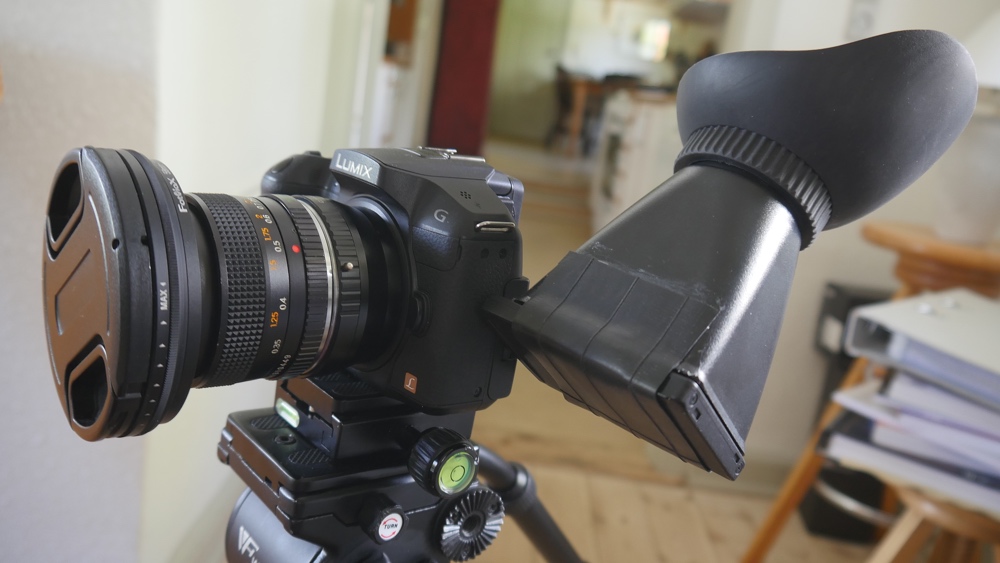-
Posts
157 -
Joined
Content Type
Profiles
Forums
Articles
Posts posted by bluefonia
-
-
9 hours ago, Axel said:
@bluefonia
Very smart. Would like to see real splitscreens/wipes in CFP nonetheless.
Yes, that would be nice. CoreMelt LUTx has the swipe, - but again - that´s a plugin...
-
Maybe I should add to this whole subject, that I don't always need or seek the newest tech solutions.
Below is my current "focus assist". As everyone clearly can see this is as low-tech as can be. A cheap $20 loupe, a piece of cycle tire rubber and some velcro. (An old picture with my G6, but I still use it on my GH4). You just wipe the rubber around the monitor and you are ready to go
 . Works like a charm, diopter enlarges x3 and yes I see pixels and the cheap diopter distorts quite a bit, but I can nail focus every time and that's what matters.
. Works like a charm, diopter enlarges x3 and yes I see pixels and the cheap diopter distorts quite a bit, but I can nail focus every time and that's what matters.
The thing is, I´m afraid that the monitors hinge will break some day.

- HelsinkiZim and JazzBox
-
 2
2
-
Quote
I was here recently too. I don't think you mentioned this, but with tech like monitors, they are quickly outdated, and I hated the thought of spending a bunch of cash on something that would suddenly feel outdated in 6 months or less. Especially if I felt like I could have gone cheaper to begin with.
I see where you are coming from. My kind of thinking was along the lines that when monitors reach a certain quality level of sharpness/resolution/contrast and so on, we reach some point where we don't need more of that sharpness/resolution/contrast and so on. Well, maybe we have not reached that point yet. About the outdated tech, - yes, I have been around that too.
In fact I have considered the new Aputure VS Fine, which- as you say - has much better resolution than the old one.
QuoteProbably not a good idea to look at 5" for focusing. Most focus pullers will say 7" is small, let alone 5". 5" is more of a framing aid.
I'm thinking along the same lines. I would indeed prefer a 5" for its small size, but I¨m afraid it will not fulfill my main purpose being a great tool for focusing,
-
13 minutes ago, Geoff CB said:
Why is the Pix E5H to much money? An extra $150 over the Atomos and better build, plus it now has the professional XLR inputs available.
I live in EU and the prices are quite a bit different than you think :-). The Pix is € 1.400 over here. This makes the Pix €350 = $408 more than the Atoms unfortunately.
-
I need a monitor for my GH4, - my old eyes simply need some assistance. I need something, which makes focusing easy and the 3" GH4 monitor is too small. The only external monitor I have used is an Aputure VS3, which did not do for me.
I have considered the following: SmallHD 501/701, BM VideoAssist 5", - and the new 7" 4K, the PIX E5H and Atoms Ninja Assassin. At first I thought I would go for a 5", but now Iám totally open for 7" as well.
My thoughts until now:
1: The SmallHDs: Cost almost the same as - or more - than some of the combined monitor/recorders, which for now has ruled them out. (Unless the screen is so much better than the competition, - then they might be worth some extra considerations).
2: The BM VA 5" is cheap, is pretty small, uses SD cards. Heard people say the screen is not the best, colors not accurate and misses some focus aiding tools and some have had frame drops at 60 fps. I can live with the missing tools and colors though, if the screen resolution/brightness/contrast is fine.
VA has 4.2.2. ProRes 1080 ecording., - how does that compare to internal 1080 or 4K?
3: BM VA 7", - records 4K and has a 7" screen. For some reason I´m a bit reductant about SD cards as recording media in this context, - don't ask me why. Otherwise the same as the 5".
4: PIX E5H, - nice, but too much money
5: Atoms Ninja Assassin, - as it is discontinued by now it can be had for around €1040. The screen and tools, - including LUTs - seem to be very nice, it is 7" and it records UHD 4K.
Have heard the fan can be somewhat noisy? Some say the build quality is so so. Any other waek points?
It seems I have to buy an extra SSD dock in order to transfer recorded footage to my computer (iMac)? If so how much €?
At this moment the Atoms gets the most points by me, but I will really appreciate any comments and experiences from those of you who has used or owns any of these units.
Thanks a lot in advance.
-
6 hours ago, Axel said:
Grading in Resolve, despite the necessary roundtrip, is still more comfortable than grading in FCP X, for different reasons. The two most prominent for me are (1) saved grades represented by stills, as described in the Resolve manual page 600:

You don't grade 20 shots separately, you grade the sequence. You start with a defining shot, and you then compare the rest to this reference and match them. Within FCP X, there are two workarounds for this (maybe you know a better one):
1. you can make a freeze frame of the reference by hitting alt+f and move it over all your other shots, making the splitscreen manually (cumbersome).
2. you can park the playhead on the reference frame and compare it quickly with "s" (skimmer on the current frame on/off). Easy, but somewhat limited. For instance, you can't directly compare the scopes which help tremendously in quickly matching shots.
This is what I hope the still store to do in CFP.
The second reason why I find Resolve more suitable right now is that every saved grade has a very clear node representation that lets you see at once what stages of correction were just for the clip and should be adjusted after copying the grade to another clip.
There is an easy way to always have a reference shot - and not a still image, but a live piece of footage - open in FCP when you want that.
You make/grade your reference shot(s), put them in a library (which you could call "ColorRef") within your working event. Then just open the event viewer and put your ref. shot in there. Then you have a constant reference to the left in the event viewer and can compare the rest of your footage to that in the player to the right,
It would be nice to have nodes. The best way for me to "copy" this in FCP is to save a preset including the different plugins and their settings for the reference shot. Then it is pretty easy to make these settings available for all shot in the timeline and make adjustments when nessecary.
-
H
1 hour ago, JazzBox said:I just bought Color Finale, because with the vectors, during the trial days, I was able to nail some nice grading.
I also have the Film Convert trial and I like it for the grain possibility: do you think it worth to have both Color Finale and FilmConvert?Hi, - it's been a long time :-).
The short answer to your question: if you want both the easy way and the option to dig deeper get both FilmConvert and ColorFinale.
The long(er) answer: Well, well, - it all depends. As a matter of fact I also have the fairly new CoreMelt LUTx and have demoed the KojiColor. They all have their weak and strong points. If you want good looking results, quickly and without much hassle - with LUTs - I think FilmConvert is a great solution. It has few LUTs, they are all good though, but FilmConvert can't load thirdparty LUTs. You can dig deeper in ColorFinale - due to the added curves, vectors and the layers, but ColorFinale has no LUTs preview function, - you have to add the LUT to see the result. The new $49 upgrade should include the option though. ColorFinale can load third party or your own custom LUTs
I would say ColorFinale is a much better grading tool if you want to develop your own grades than FimConvert, - it is really good for both primary and secondary corrections. If it had masking tools it would be close to perfect. I find the color wheels are difficult to adjust though, but that might just be me.
If you want to mess around with lots of LUTs CoreMelt LUTx has great preview options and nice browser functions for organizing all the LUTs in the world. Has also pretty good color adjustment tools. KojiColor like FilmConvert has few but well executed LUTs and some nice color adjustment features. Does not load third party LUTs.
EDIT: If I should choose only one I would take ColorFinale. After spending a great deal of time lately with all the above plugins I think in the feature I´ll try and make my own style of "looks" and for that purpose ColorFinale is a better tool.
- foliovision and JazzBox
-
 2
2
-
I already think I have enough batteries, cables and powersupplies to carry around, - so back to simple and proved equipment: I just ordered a Laing H3, - which is the same thing as a Came H4. Maybe this is going to be the new black, - or white or pink,- whatever... :-).
-
I have both the plugin and the standalone version.
The color wheels part of the plugin GUI I find much to small and very hard to adjust. Then if you want to use the wheels to adjustments for many cuts, I would use the standalone version. In my normal workflow first of all I edit my footage to get the story right, then adjust exposure/levels and colors/saturation to my liking. Then I make secondaries, - masks for separate areas and so if needed. Sometimes I make compound clips for parts of the film. As the last part I add LUTs/looks - or make my own grading - and film grain if needed. This last step I normally do on an adjustment layer and this is where Filmconvert can be used the best as a plugin imo, - and it does not involve a lot messing with the color wheels.
If you don't have too much footage- or have reviewed and sorted the footage - and you know for the most part before editing how you want the finished filmgrade to look, you might import the footage in FC standalone, make the grade and import that into FCP. Some people import the final edited film into FC and do the grade. I guess there is no right or wrong here, it all depends on your on preferred workflow, - and on the power of your Mac it seems :-)
For some reason I like to stay in the same application for all steps of my editing and grading.
-
17 hours ago, DBounce said:
He'said right. If using prores with Adobe CC in Windows you need QuickTime. Does FCP have a Windows version? Is FCP Adobe CC? Seems someone went to the wrong forum.
@Axel said, - quote:
"Adobe seems to have done some homework. In their official statement, it sounds as if no QT was needed to read (i.E.) ProRes or other movs. And why should it? Many companies have their own, proprietary codecs, and wasn't it always Adobes pride to support those without need for plugins (what IS that QT actually, as far as ProRes is concerned?)?"
Quote@DBounce: "Seems someone went to the wrong forum."
Not everyone is religious about the gear they use :-)
-
3 hours ago, cantsin said:
The problem is that "player" does not only refer to the QuickTime Player app, but to the playback component that most Windows NLEs (including Premiere, Avid, Edius, AE, Resolve, Vegas) use for loading and playing back .mov files.
According to several technical clever people at fcp.co, the drop of Windows Quicktime support affects only browsers, - not NLE playback.
-
Yashica ML primes are very nice. Only downside is they don´t have a 85mm, - there is a 100mm though. But you can get a Zeiss 85mm. The Yashicas and Zeiss ar close related and will probably blend well together and share the same mount - contax/yashica.
-
21 hours ago, DanC1 said:
Sweet, hope you're getting a good deal ?
Thanks, - investing all the profit i Panama

-
-
I also have ColorFinale. Agreed, - I think a combonation of the two would be optimal.
I find the color wheels in CF too small and not very precise to work with and having to actually add a LUT before you see the results is cumbersome imo.. I do like the vectors and curves a lot and the ability to stack/reorder different corrections/LUTs.
A mix of these CF features with LUTx´s browser, preview, RGB-sliders and masks in one plugin would make an almost ideal solution.
-
Looks good....
I just made a quick test too. Here is a frame grab from some GH4 V-LOG test footage: the original ungraded log-file and a very quick grade. This plugin has a very fast workflow and you get nice results very easily even without using all the features.
I have imported the luts I already had, - Impulz, Osiris and WLTBAP - into LUTx. Works flawless and they also appear in the preview- and swipe feature in LUTx, - nice.
So, - I just send $29 to CoreMelt...
-
I have played around with the trial for a hours time now. So far I like it. The adjustments for the lows/mids/highs are indeed nice, but what I like almost the most is the swipe function (the white cursor that appears in the player window) for checking before and after LUTs and other adjustments. This I find extremely helpfull as it helps you not to overdo any adjustments.
-
It has some really nice features, - among them is the best preview and before-after function I have seen until now. Includes camera specific LUTS. Can import LUTs form other vendors too. And it is cheap, - intro offer $29.
-
It is a dangerous world out there....
-
-
5 hours ago, jonpais said:
To OP: here's an article you might find interesting.
Thanks, the article added so mileage to my limited knowledge about zoom lenses.
Besides owing the Sigma, I recently got two Zeiss Vario Sonar zooms, - F3,5-5.6 and F4 respectively. The Sigma is constant F1.8. The two Zeiss zooms stays in focus aprox. 75-80% of the zoom range while the Sigma stays in focus less than 50%. Wonder if the quite big difference in F-stops have some importance on the matter too?
-
8 hours ago, BenEricson said:
You sure all of your lenses properly focus to infinity? I adjusted for the sigma and everything was perfect after that, this includes fisheye lenses and non native zoom lenses with adapters.
I´m pretty sure they focus to infinity, but I think I´ll double check all of them, - both with and without SB.
-
Thanks, - in fact I'm already aware that Metabones SB¨s can be adjusted if needed. I have one in CY/MFT mount, but have had none of these backfocus issues so far. I just made the final zoom/focus test without SB to exclude all possible error sources.
-
If your main purpose for traveling is filming then go for 5D, C100 - or Arri Alexa for that matter :-) - and a bunch of glasses and lots of batteries and so on.
On the other hand If your main purpose for traveling is to have great experience while you are there together with your brother, the local people you meet and so, I would choose less - in all aspects - demanding equipment. It could well be a Panasonic G7, a vari ND and a couple of good lenses. You will get fine quality footage, you don-t attract much attention to your filming -most people will think you are just taking a picture - , your back will love you, - should you, I hope not , loose your camera, you can afford to buy another one, batteries will last long. The list goes on.
I live in Scandinavia and went to California, - SF, Yosemite, Big Sur and more - for 2 weeks equipped with 2 friends, my son and a Panasonic G6, the before mentioned vari ND and a couple of lenses. I would have hated to walk around with more gear than this. I got splendid footage that cut me a film I will love to see in 25 years from now.





FilmConvert Workflow?
In: Cameras
Posted
When this happens, do you have other "operations" - (does that make sense?) - waiting for rendering? And do you use 4K footage in a 1080 project/timeline? In such scenarios I sometimes run into these playback issues. If nothing - or not too much - are waiting to render, the FC plugin usually plays back ok for me.